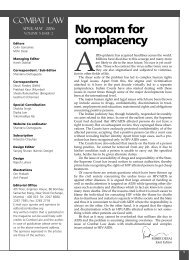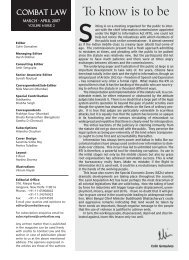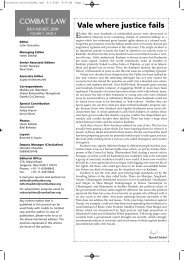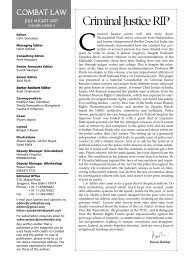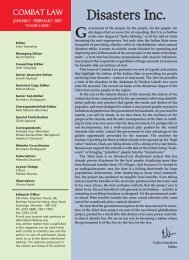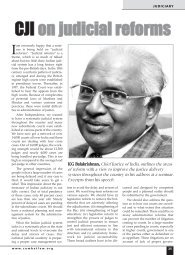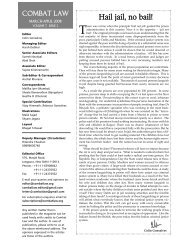PDF, 1.1MB - Combat Law
PDF, 1.1MB - Combat Law
PDF, 1.1MB - Combat Law
You also want an ePaper? Increase the reach of your titles
YUMPU automatically turns print PDFs into web optimized ePapers that Google loves.
child rights Access to safe drinking waterand access to proper sanitationfacilities has improved for 816million and 747 million peoplerespectively. Enrolment in primary educationhas increased and the globalgoal set in 1990 at the WSC(80% enrolment) has beenachieved. In 2001, 21 countries reportedthat school enrolment andretention of girls increased (inSouth Asia the gender gap inschool enrolment was reducedby 20%).From these and other figures it isclear that the implementation of theright to the highest attainable standardof health and of the right tofree and compulsory primary educationhas made considerableprogress. But still a lot remains tobe done (see The Challenges);In the period 2000-2001 more than1000 working children and almost30,000 parents have benefited fromthe ILO-IPEC programmes.Thousands of child soldiers havebeen demobilised thanks to actionsby UNICEF and those supported byother UN agencies and NGO’s. Forinstance, 2,400 in Angola, 2,600 inthe Democratic Republic of Congo(Plan of Action 2002), 6821 in SierraLeone (since October 1999) and3,351 in Sudan, since February2001. Education, psycho-social, andmedical support was provided to thethousands of child victims of armedconflicts.Improvements can also be recordedin the area of special protectionalthough they are still very moderategiven the magnitude of the problems(see The Challenges); they areclearly less impressive than in theareas of health and education.The Challenges: What ToDo?Despite the achievements mentionedin the previous paragraph,the world is not yet a place fit for fartoo many children. Some facts toillustrate this; 600 million children have tolive, that is to be fed, clothed,housed, and educated with lessthan $1 US per day. Even in therichest countries of the world,one in every six children (about47 million) live under thenational poverty line. 21 million children aged 5-14are engaged in some form ofeconomic activity, and 186million of them are engaged inthe worst forms of child laborwith the same applying foralmost 60 million children age15-17 years. About 110 million of thoseworking children of primaryeducation age do not receiveany education at all. About 11 million children dieevery year of preventable diseases,that is about 20,000 perday, a fact that goes withoutanymediaattention. At the end of 2001, there were2.7 million children under 15years living with HIV/AIDS. Inthat year, 800,000 childrenunder 15 years were newlyinfected with HIV and 580,000children of that age group diedof AIDS. The number of Africanchildren who had lost theirmother or both parents by theend of 2000 is estimated at 12.1million and is forecast to morethan double over the nextdecade. Polio is still endemic in 20 countries,while less than 50 percentof children under one year ofage in Sub-Saharan Africa areimmunized against DPT 3. Inmore than 15 countries, themeasles vaccination coverage isless than 50 percent. In the past decade two millionchildren died as a direct resultof armed conflicts and an additionalsix millions were injured19 combat law • April - May 2004or disabled.More facts and figures can be presentedto show that the world is stilland by far not a place fit for children.Think, for example, of the 11million refugee children, the manymillion child victims of violence andabuse in their homes, their institutions,their schools, their workplaces and the streets. The UN’sGeneral Assembly – following a recommendationof the CRCCommittee-decided to request thatthe Secretary General conduct an indepth international study with thesupport of a secretariat establishedby UNICEF, the WHO, and theOHCHR.From the above listed and manyother overwhelming problems itis clear that the internationalcommunity faces many challenges inits attempt to implement theCRC and make the world fit forchildren.The problems seem to be almostinsurmountable, and it may be difficultto decide where to begin, giventhe reality that not all problems canbe tackled at the same time. Thetraditional opinion is that governmentsof States Parties need tomake their own choices and set theirown priorities. This is rightly so,because the problems in theNetherlands, for example, are quitedifferent from those in South Africa,which in turn are different from theproblems in Brazil or Indonesia.But, the setting of priorities is notan arbitrary matter, or a lottery.The goals that the 191 StatesParties have committed themselvesto, are clear and can be found in theUN Convention on the Rights of theChild which they ratified voluntarilyand wholeheartedly. These goalsare elaborated upon in detail in theDeclarations and International Planof Action, A World Fit For Children,(WFFC) which was adopted unanimouslyby all members of the UN inMay 2002, including those whichhave not yet ratified the CRC. In



